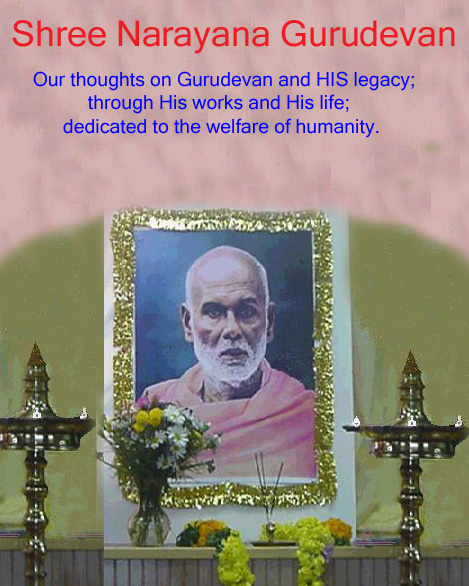Now in this process of elimination, some people cannot see the Athman? Who are they? “who has no understanding and whose mind is never firmly held, her/his senses are unmanageable, like vicious horses of a charioteer.” And also, “who has no understanding; who is unmindful and always impure” also cannot reach the Athman (as they can never see the braHMan but enters into the round of ‘births and deaths’).
Then
who sees the braHMan? “That Self is hidden in all beings and
does not shine forth, but it is seen by subtle seers through their sharp and
subtle intellect.” Also, “who has
understanding and whose mind is always firmly held, who’s senses are under
control, like good horses of a charioteer”, And “who has
perceived that which is without sound, without touch, without form, without
decay, without taste, eternal, without smell, without beginning, without end,
beyond the Great, and unchangeable,” can “see the Athman
and they shall be freed from the jaws of death, and attain mokSham, whence
they shall not be born again.''
The
wise one who seeks Athman ‘should restrain speech in mind; the latter
(the mind) in the understanding self. The understanding self, should restrain
in the Great Self; that they should restrain in the tranquil Self.' Also, “Remember
and understand that the sharp edge of a razor is difficult to pass over; thus
the wise say; the path (to the Self) is hard.''
That
is the reason, in Bhagavad Geetha; ShRee KRishna bhagwAn asked Arjunan
to abandon “all forms of rights and duties and take refuge” in HIM alone and
HE promised that HE shall free ARjunan from all sins. Remember here, HE
means the parabrHMam not the shree KRishna bhagwAn in human form.
“The
wise who, by means of concentration of the Self, realizes that ancient,
effulgent One, who is hard to be seen, un-manifest, hidden, and who dwells in
the buddhi and rests in the body, he, indeed, leaves joy and sorrow far
behind.” “The mortal who has heard this and comprehended it well, who has
extracted the essence from all qualities, and has thus reached the subtle (Athman),
rejoices, having attained the source of joy. For them the abode of Brahman - (ബ്രഹ്മൻ) is open, I
believe”.
The
‘I’ factor, the ‘ego’ accepted the experiences of the materialistic world and
thus the
“Athman”
was lost under the cloud of the ‘ego’. However the search for it with the aid
of
“Thapasya”
- (തപസ്യ), we trace
back to the origin and thus understand the Truth. When this happens, the ‘Self’
alone shall shine. This will in turn help us to realize the ‘Absolute like ten
thousand suns coming all at once’, which will cause to arise the modulation of
the discriminatory power of ours and it will remove the veil of transience
covering the fact of the Absolute. And that Absolute shall shine like a glowing
raising sun which removes all the darkness. Thus, the ‘I’, born out of the paramAthman,
returns to the same paramAthman; and merges into it thus attaining the
Ultimate Bliss (മോക്ഷം). This is the
stage Gurudevan explains in verse 97of (ആത്മോപദേശശതകം) admopadeShaShathakam.
അണുവറിവിന്
മഹിമാവിലംഗമില്ലാ-
തണയുമഖണ്ഡവുമന്നു പൂര്ണ്ണമാകും;
അനുഭവിയാതറിവീലഖണ്ഡമാം ചിദ്-
ഘനമിതു മൗനഘനാമൃതാബ്ധിയാകും.
തണയുമഖണ്ഡവുമന്നു പൂര്ണ്ണമാകും;
അനുഭവിയാതറിവീലഖണ്ഡമാം ചിദ്-
ഘനമിതു മൗനഘനാമൃതാബ്ധിയാകും.
AnuvaRivin
mahimAvilangamillA-
thaNayumakhaNDavumannu
poorNNamAkum;
anubhaviyAtaRiveelakhadamAm
chid-
ghanamithu
mounaghanAmrtAbdhiyAkum.
Meaning:
The finite will disappear in the glory of infinite knowledge, leaving no trace
of its finitude; on that day the infinite will attain perfection; without
experiencing it, one does not know this boundless pure consciousness; it is the
silence filled ocean of immortal bliss.
The jeevAtman,
or the ‘I’ will disappear into the vastness of paramAthman, (the
Absolute) leaving no trace of itself at the time of the attainment with an indivisible
perfection. Just like the rivers merge into the ocean and loses its identity,
in an undividable merger. Without direct experience one does not know or
understand this unbroken consciousness; which is the solidified and endless
immortal bliss. When we end the mantRam by declaring ‘dRukku pOluLLam
ninnilspandamAkaNam’ (ദൃക്കുപോലുള്ളം
നിന്നിലസ്പന്ദമാകണം) this is what
we are asking the Absolute to grant us.
Shree
Adi ShankarAchAryaR says “by a process of negation of the conditionings (upAdhis)
through the help of the scriptural statement “it is not this, It is not this,
the oneness of the jeevAthman and the braHMan as indicated by the great MahAvakyas,
has to be realized.
This
process of elimination will bring the “I” into a ‘stage of oneness’ with the
Absolute. This is realized by the Athman which was nothing but the “I”
or “ego” in us. So that ego has now realized as the Athman. At this
stage of realization we will be able to understand that, there are only two
true experiences and that are the ‘I’ the Athman, and the Ultimate Truth,
which is the braHMan. {It will also be understood that in fact these
both are not separate but one and the same.} This is known as savikalpasamAdhi
(സവികല്പസമാധി). Gurudevan calls this as kEvalathin
mahima
(കേവലത്തിൻ
മഹിമ)
in mantRam thirteen of admopadeShaShathakam.
The utmost point the “I”, the ego can reach that is what kEvalathin mahima (കേവലത്തിൻ
മഹിമ)
is? Once it (the “I”; ego) is there, it realizes that every one of us can be at
that stage and the “I” factor disappears on further Thapasya and this is
where the “I” or the Athman merges into the Absolute and becomes one ‘with
HIM’. This is the stage known as (നിർവികല്പസമാധി) nirvikalppasamAdhi. Here the ‘Athman’,
the jeevAthman (“I”), and the collection of all the jeevAthman
(all the “I”s) which is the ‘we’; all of us; becomes part of the braHMan
without differentiation of individuality. No more me, you, he, she etc and it
all becomes ONE; Ayam Athma Brahman, (This Self – Athman
- is
BraHMan); Tat Tvam Asi, (Thou art that); and Aham BrahMAsmi, (I
am BraHMan) and PRajnAnam BraHMan, (Consciousness is Brahman).
